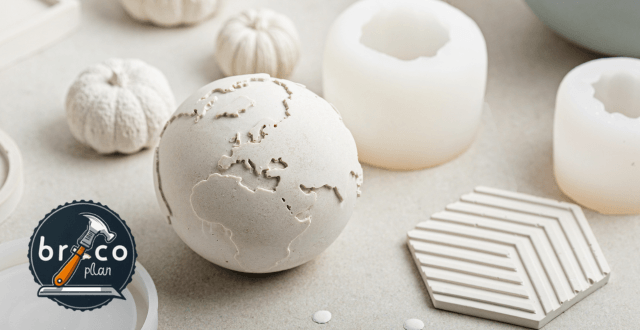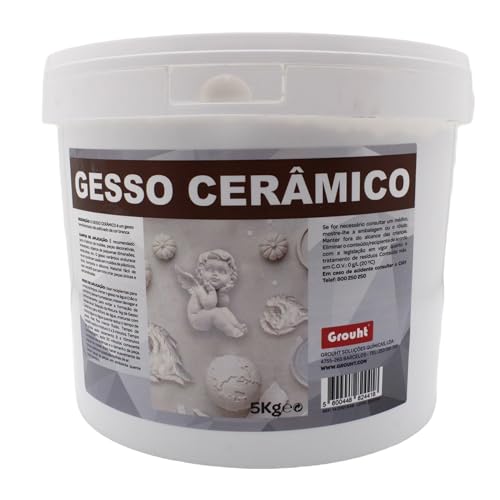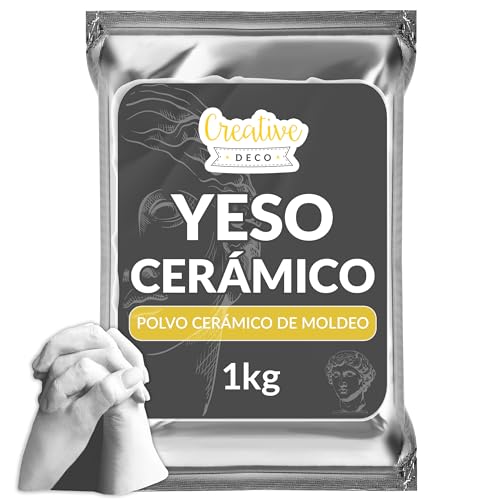
The Ultimate Guide to Art Plaster, Ceramic Plaster, and Modeling Plaster: Discover Their Uses and the Best Options for Your Creative Projects
When it comes to creative projects, Ceramic Plaster, or Artistic Plaster, is a must-have material for any artist, sculptor, or DIY enthusiast. Since ancient times, this white powder has been the basis of countless masterpieces, and today it remains a fundamental ally in the world of art and creation.
But, What is the difference between artistic plaster and ceramic plaster or modeling plaster? Which one is best for your projects? In this guide, I'll help you unravel the characteristics of each type of plaster and how to choose the right one to bring your ideas to life.
What is Artistic Plaster and what is it used for?
Artistic plaster is a versatile and easy-to-use material, ideal for artists, sculptors, and artisans looking to create both temporary and permanent works. This type of plaster is characterized by its fineness and ability to capture details, making it perfect for sculpting, molding, and high-quality finishes.
- ONE UNIVERSAL UNDERLAYER: Prepare all your surfaces with this multi-surface gesso that can be used on all surfaces.
- EASY TO APPLY: Apply a thin coat of this universal coating to your surface using a flat brush, a squeegee, or a…
- FAST DRYING: Prepare your brushes, palette, and acrylic paint cans while the acrylic layer dries. In menu…
- Non-toxic, thixotropic synthetic plaster with high hardness and strength. Ideal for prints and positives.
- High precision in detail reproduction combined with very high hardness (achieved after 48 hours) makes…
- Contents: 1 kg pack of high-quality synthetic plaster
Advantages of Artistic Plaster
- Versatility: It adapts to a wide variety of projects, from small sculptures to large installations.
- Easy handling: Its fine texture allows for working with great precision.
- Quick drying: Ideal for projects that require a short execution time.
- Compatibility with other materials: It can be combined with resins, pigments and other additives to further customize creations.
Ceramic Plaster: Characteristics and Uses
Ceramic plaster, on the other hand, is specifically designed for the creation of molds in the ceramics industry. Its main advantage is its ability to withstand high temperatures, making it the ideal material for creating molds for the manufacture of ceramic and porcelain pieces.
- ✔️HOW TO USE: Cold ceramic to mix with water, inhibit the product with 30% water for example: 100 g of Fil Ceramic…
- ✔️VARIOUS USES: Ideal for creating larger, more robust chalk trays, bowls, boards, and decorative items.
- ✔️WORKABILITY: 5-7 min. 20-25° – Once dry and solidified, the cast object is ready to use after 30 minutes of…
- Total Versatility: Ideal for creating molds, decorative pieces, crafts, figurines and small objects.
- Air Hardens: Ceramic plaster hardens in air, making the creation and modeling process easier.
- Mold Use: Compatible with plastic, latex, rubber, and silicone molds, allowing for a wide variety of applications…
- 1kg
- Amateur and professional adults
- Practical bag, with closure
Why choose Ceramic Plaster?
- High temperature resistance: Perfect for ceramic firing processes.
- Durability: Ceramic plaster molds have a long lifespan, supporting multiple production cycles.
- Precision: It allows for the reproduction of fine details, which is crucial in artistic ceramics.
Plaster of Paris: The Favorite of Sculptors and Artists
Modeling plaster is a type of plaster specifically designed for creating molds and sculptures. Its thicker consistency makes it ideal for work requiring volume and structure. It's the material many sculptors choose as an intermediate step before moving on to more permanent media such as bronze.
- APPLICATION – Creative Deco moulding plaster is used in the gallantry and stucco work of figures, trays, saucers, pots…
- HIGH QUALITY – The ceramic plaster has been manufactured with the highest quality ingredients, thanks to which the molds…
- EASY TO USE – Measure 100g of powder and 60g of water, and you can add colorants and pigments. If the consistency is too…
- Total Versatility: Ideal for creating molds, decorative pieces, crafts, figurines and small objects.
- Air Hardens: Ceramic plaster hardens in air, making the creation and modeling process easier.
- Mold Use: Compatible with plastic, latex, rubber, and silicone molds, allowing for a wide variety of applications…
- High-quality studio plaster for decorative and creative work
- 1.5 kg in bag
- Easy to mix with water, instructions on the package.
Common Uses of Modeling Plaster
- Mold making: Perfect for reproducing shapes that will later be cast in materials such as metal.
- Sculpture: Ideal for artworks that require both detail and volume.
- Prototypes: Before moving into mass production, plaster modeling allows for the creation of detailed and realistic prototypes.
Comparison between Artistic Plaster, Ceramic Plaster and Modeling Plaster
Below is a comparison table to help you quickly see the differences and similarities between these three types of plaster:
| Feature | Artistic Plaster | Ceramic Plaster | Modeling Plaster |
|---|---|---|---|
| Texture | Fine, allows great detail | Thin, but more resistant to high temperatures | Thick, ideal for volume |
| Drying time | Fast | Moderate | Moderate |
| Main uses | Sculpture, carving, crafts | Ceramic molds | Sculpture, mold making |
| Durability | Media | High, supports several cooking methods | High, especially in molds |
| Compatibility with other materials | High, can be mixed with resins and pigments | Media, it is mainly used alone | High, can be combined with other materials |
| Price | Accessible | Moderate to high | Accessible |
What is the best plaster for your projects?
The choice of plaster type depends on the project you have in mind. If you're looking for a material for detailed sculptures and DIY projects, artistic plaster is your best option. For those working with ceramics and needing to create durable molds, ceramic plaster is the way to go. Finally, if your goal is to create molds for casting or three-dimensional prototypes, modeling plaster won't disappoint.
User Reviews: What Do Artists and Craftspeople Say?
I've compiled some opinions from users who have used these products, based on reviews on Amazon and other specialized platforms. These opinions will give you a better understanding of other artists' experiences with these types of plaster.
| Product | Opinion | Valuation |
|---|---|---|
| Artistic Plaster | "Excellent for detailed sculptures. Easy to work with and dries quickly." | ★★★★★ |
| Ceramic Plaster | "Ideal for ceramic molds. It withstands firing perfectly without warping." | ★★★★☆ |
| Modeling Plaster | "Perfect for creating prototypes and volumetric molds. Very durable." | ★★★★★ |
Pros and Cons of Different Types of Plaster
To help you make the best decision, I've put together a table summarizing the pros and cons of each type of cast.
| Type of Plaster | Pros | Contras |
|---|---|---|
| Artistic Plaster |
|
|
| Ceramic Plaster |
|
|
| Modeling Plaster |
|
|
FAQ – Frequently Asked Questions about Ceramic Plaster
Conclusion
I hope this guide has provided you with the necessary information to choose the right plaster for your projects. If you have any questions or experiences you'd like to share, please feel free to leave a comment. I'm here to help you turn your ideas into reality!
Recommended Articles
- How to Organize Your DIY Workshop at Home: A Practical Guide
- How to Repair Cracks in a Wall: Step-by-Step Guide
- Home Repairs Everyone Should Know How to Do
- Self-Leveling Mortar: Uses, Advantages and Keys
- 20 DIY Business Ideas to Sell Fast at Home
- The Best Japanese Saws: The Ultimate Guide
- Transform Your Home's Entrance with Custom Doormats
- Bricoplan: DIY Projects for the Home
- The Best Brush Cutters for Your Garden: Complete Guide
Was this information helpful? Share this article on your social networks and Subscribe to our newsletter so you don't miss any news on DIY and renovations.










